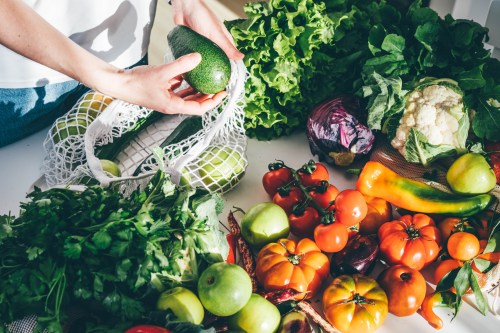Our editors independently select these products. Making a purchase through our links may earn Well+Good a commission
Why Drinking Rainwater Is a Promising Cloud-to-Bottle Solution to Renewable Water Sourcing
Sustainability experts weigh in on how rainwater collection might help be the cloud-to-bottle solution for renewable water sourcing.

Nearly 71 percent of the Earth’s surface is covered with water, but because 97 percent of that water is found in the ocean (and is therefore saturated with salt), just 3 percent of the world’s water is considered fresh. And according to the United States Bureau of Reclamation, 2.5 percent of that fresh water is available for consumption or other uses, like growing crops. Put plainly: It’s not enough.
Experts in This Article
According to UNICEF, an agency of the United Nations responsible for providing humanitarian and developmental aid to children worldwide, over 4 billion people—almost two-thirds of the world’s population—currently experience severe water scarcity for at least one month each year. And by 2030, 700 million people could face displacement due to water scarcity resulting from climate change and other environmental factors. As water scarcity threatens the well-being of the ecosystem and the lives of so many humans in it, preserving water as a renewable resource is imperative.
It’s a huge problem, and solving it is fraught with challenges. One factor straining our planet’s present and future freshwater stores that consumer habits stand a chance at reversing? In hopes of curtailing water scarcity in the future, though, some brands and environmental experts are turning to rainwater as a reliable, renewable water source, particularly for sourcing the bottled water industry.
Roughly 75 percent of our bottled water supply today comes from ground sources, like springs and wells. But according to environmental experts, harvested rainwater is one promising sustainable renewable water resource to tap.
What to know about rainwater—and using it for our bottled water supply
A quick refresher on how the water cycle works: At its most simplistic, liquid water comes down to Earth from the atmosphere as rain or snow, then flows across land or goes into the ground. Water is then reabsorbed into the atmosphere through evaporation from lakes and rivers, or is taken up by plants and then released. Finally, vaporized water condenses to form clouds, and the cycle begins again.
“Capturing rainwater is one of the key ways to maintain a water supply.” —Aaron Packman, PhD, environmental engineer
Harvesting rainwater means capturing precipitation before it lands on the surface of the Earth, and this source of water has long been identified as a viable alternative water technology by the Environmental Protection Agency (EPA) and Federal Energy Management Program (FEMP), which states that rainwater harvesting systems are readily available and can provide an opportunity to offset the use of fresh water. A 2020 study conducted in Tucson, Arizona, also found that rainwater may be able to replace imported water sources in water-stressed cities and achieve a 30 percent demand conservation. The study also pointed to rainwater as a possible net zero urban water resource—meaning its harvesting contributes as close to zero harmful greenhouse gas emissions into the atmosphere as possible—under multiyear drought conditions with large storage volumes.
“Capturing rainwater is one of the key ways to maintain a water supply,” says Aaron Packman, PhD, a professor of civil and environmental engineering at Northwestern University and the director of the Northwestern Center for Water Research. “It’s been done for centuries in plenty of places around the world, particularly areas where folks keep a cistern on top of their roof. Rainwater can be used both around the house and as irrigation for crops.”
How Richard’s Rainwater is making harvested rainwater more accessible
Richard’s Rainwater, a Texas-based company that launched in 2002, has been at the helm of harvesting rainwater and using it as a renewable source for its line of products: bottled and canned sparkling and still waters, all made plastic-free. Commonly referred to as the nation’s first “cloud-to-bottle” water bottle business, Richard’s Rainwater has raised nearly $20 million in funding to date. While the concept of capturing rainwater as a source of drinking water is far from new, this brand’s team of environmental experts are doing it on a significantly larger scale. In fact, in January, Richard’s Rainwater opened the world’s largest potable rainwater collection site in New Orleans, which it reports is capable of collecting over two million gallons of water per year. It also works with the Mississippi-based Lazy Magnolia facility.
Richard’s Rainwater works by capturing surplus rainwater in stainless steel tanks, which are capable of collecting up to 600 thousand gallons of rainwater at a time. In regions with bountiful rain seasons, the tanks are emptied and refilled multiple times a year.
“At Richard’s Rainwater, we’re seizing the opportunity to use a resource that’s quite literally falling from the sky,” says Serena Dietrich, the company’s director of sustainability. “And when rainwater is harvested, it’s in the purest possible state water can be.”
And while Dr. Packman agrees that rainwater poses a lower risk for contamination than groundwater—which is exposed to soil, wastewater, urban runoff and more—rainwater isn’t without risk. “Water falling through the atmosphere can meet gasses or particulate matter, which can contaminate rain. Think of acid rain,” he says. To that point, recent research has raised concern over the presence of PFAS (per- and polyfluoroalkyl substances, aka potentially toxic “forever chemicals”), which have been found at unsafe levels in rainwater around the world. This is why companies like Richard’s Rainwater employ reliable filtration systems to effectively remove PFAS and other potentially harmful contaminants from harvested rainwater, rather than suggesting anyone drink rain straight from the sky. And according to Richard’s Rainwater’s 2022 annual water quality report, PFA levels higher than the predetermined detection limit weren’t detected in any of their products.
To further ensure the rainwater collected in its facilities is in its cleanest form, the team at Richard’s Rainwater looks to a few other purification processes. “After the first 15 minutes of a rain event, the air has been totally wiped clean. This is why we reject the first 30 minutes of rain collection—we want to avoid the slim chance that any of that pollution could end up in our tanks,” Dietrich says. What’s harvested after the first 30 minutes of rainfall is then further purified and bottled for sale, she adds, noting that this is standard practice for any type of rainwater collection.
Richard’s Rainwater also believes in the importance of eliminating plastic waste. Today, people use roughly 1.2 million plastic bottles per minute, and approximately 91 percent of which is not recycled. Meanwhile, the Great Pacific Garbage Patch (GPGP), the largest accumulation of ocean plastic in the world located between Hawaii and California, has grown to 1.6 million square kilometers: an area twice the size of Texas or three times the size of France. In an effort to avoid contributing to the damage, Richard’s Rainwater is sold in sustainable, BPA-free, plastic-free packaging made from recycling-friendly glass or aluminum cans only.
The clear benefits of bottled rainwater production
To ensure any form of bottled water is safe to drink, it must undergo a series of disinfection processes. Both groundwater and rainwater rely on ozone water treatment, which uses ozone (a colorless, odorless reactive gas) to eliminate contaminants like bacteria, viruses, and metals through oxidation. This fast, effective, and chemical-free way to purify water has been linked to positive health outcomes for consumers, including treating certain types of dental procedures, wounds, and circulatory disorders.
Aside from the ozone water treatment, disinfection between the two forms of water looks quite different. Rainwater disinfection involves pretreatment with UV light to kill most pathogens, then filters designed to remove only what’s leftover after the first step. Then the water gets ozonated and bottled. Meanwhile, bottled water that’s been sourced from groundwater often gets disinfected by starting with a chlorinated source of water like municipal tap water, stripping out its chlorine content using carbon filters, and ozonating it.
According to Dietrich, rainwater purification doesn’t involve chlorine, which she says can leave an unpleasant odor or aftertaste. (Some researchers have even identified toxic and carcinogenic by-products that can be produced when chlorine is added to regular drinking water.) However, it’s important to note that the Environmental Protection Agency (EPA) does not classify chlorine as harmful in the quantities used to disinfect drinking water sources.
Packaging rainwater also results in less wasted water. “Anywhere from 10 to 40 percent of water is wasted using other bottling methods,” Dietrich says. “The point to highlight is that the ratio of water use—on average—for our competitors is 1.39 liters for one liter of bottled water. That’s almost 40 percent. Meaning nearly half a liter of water gets wasted in the process of bottlling a single liter for use. [When processing rainwater], we have minimal steps, so there’s minimal waste. Over 95 percent of the rainwater captured is put into our bottled products, from start to finish.”
How sustainable is drinking rainwater?
To summarize, drinking rainwater poses two significant potential benefits: It’s a naturally “cleaner” source of drinking water and requires a less wasteful purification process than groundwater. But Dr. Packman says there’s more to investigate before we’re able to officially deem harvested rainwater a more sustainable option.
“If you’re looking at sustainable solutions, you want a relatively localized water supply, you want to use it sustainably, and you don’t want to overdraw it so that it continues to replenish over time.” —Dr. Packman
For starters, Dr. Packman questions how plausible it is for rainwater capture to be possible globally (or even nationally), especially given that much of the planet doesn’t receive consistent year-round rainfall. This, he says, could very well limit the accessibility, availability, and even sustainability of capturing down the road. Dietrich agrees, noting that expansion will be necessary to provide rainwater on a mass scale. “According to Richard’s Rainwater’s calculations, it would take about 15 to 20 collection sites spread across the country to make rainwater harvesting a national decentralized concept capable of about $100 million in annual sales,” she says.
Moreover, Dr. Packman raises concerns over the impact that sourcing rainwater could have on other ecosystems. “If you divert large amounts of rainwater into reservoir storage, you keep it from going downstream. This naturally raises a lot of questions,” he says. That said, he notes that likely won’t be the case regarding Richard’s Rainwater’s operation. “Instances of that happening are likely going to be alongside a much larger-scale engineered water extraction and not just rainwater capture,” Dr. Packman says.
From Dr. Packman’s standpoint, in a perfect world, the most sustainable water source checks three main boxes: “If you’re looking at sustainable solutions, you want a relatively localized water supply, you want to use it sustainably, and you don’t want to overdraw it so that it continues to replenish over time.” The source should also have efficient treatment and distribution methods, he adds, which isn’t always the case. “There are just so many different local conditions to account for,” Dr. Packman says.
All to say, drinking rainwater isn’t the sole solution to the water crisis everywhere, but initiatives like Richard’s Rainwater is making waves in the right direction to collect rainwater where they can. And when it comes to our future water supply, every last drop in the bucket counts.
Sign Up for Our Daily Newsletter
Get all the latest in wellness, trends, food, fitness, beauty, and more delivered right to your inbox.
Got it, you've been added to our email list.










